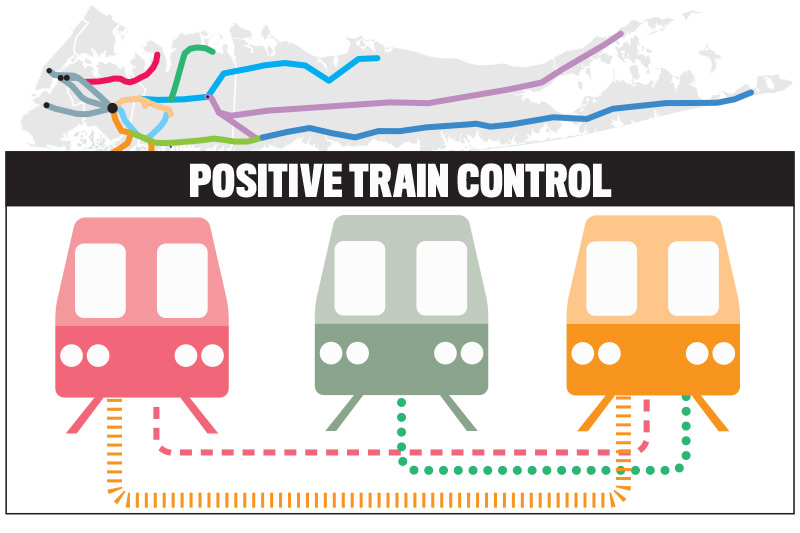Billions of dollars in infrastructure investments being made now on the LIRR could transform how Long Islanders live and commute within the next five years, experts said.
From new trains to new stations to new tracks, several big-ticket improvements long debated for the Long Island Rail Road are now approved, funded and on the way.
Taken together, the convergence of major railroad enhancements provide a stark contrast to the misery commuters have endured leading up to, and during, the ongoing “summer of hell” that resulted from the LIRR struggling to reconcile record ridership with antiquated assets.
The fact is our region hasn’t seen such a massive investment in our transportation system since Robert Moses built Long Island’s parkway system.
– Kyle Strober, executive director of the Association for a Better Long Island, a planning group
Some of the projects were conceived decades ago, such as a third track along the LIRR’s congested Main Line in Nassau County. Others seek to take advantage of emerging technology, including computer systems that can automatically prevent train crashes.
What this potentially will mean for the LIRR’s 308,000 daily riders is shorter commutes, fewer rush-hour delays and cancellations, safer trains, and for some, a way to avoid the maddening conditions at Penn Station.
Chris Jones, chief planner for the Regional Plan Association, a nonprofit planning group, doesn’t think all these projects are a panacea, but said “you can’t underestimate the improvements that will be there once all these projects are done.”
The changes coming to the LIRR will also provide better access to high-paying jobs, bring more income back to local businesses, increase home values, and help retain the next generation of Long Islanders, experts said.
It’s going to be the greatest transformation of the LIRR since it began. It’s long overdue.
– Gov. Andrew M. Cuomo, in a telephone interview Friday
Here’s a look at some of the key improvements that are in the pipeline:
East Side Access
BUDGET: $10.2 billion
ESTIMATED COMPLETION: December 2022
WHAT IT WILL DO: The project, described as the largest public works effort under construction in the nation, aims to bring the LIRR to a new eight-track, bi-level station underneath Grand Central Terminal via six miles of newly bored tunnels from Queens to Manhattan. The Metropolitan Transportation Authority predicts some 162,000 customers will travel to and from the LIRR’s new Manhattan terminal, which will include a 350,000-square-foot customer concourse and 25,000 square feet of new retail space.
Project proponents say the new, direct connection to Manhattan’s East Side will save some commuters up to 40 minutes a day in travel time. It will also provide the LIRR and its riders an alternative to the aging and disruption-prone Penn Station.
STATUS: Ten years after major construction began, significant progress has been made on the project, jointly funded by federal grants and the capital program of the MTA, the LIRR’s parent agency. Major tunnel boring was completed about five years ago and the MTA last year awarded its last major construction contract, which will include putting the finishing touches on the new station. But delays and cost overruns have plagued the project, which was once forecast to be finished by 2009 at a cost of $4.3 billion. Project officials have said recently they are falling further behind, in part because of the lack of cooperation from Amtrak at a critical work site in Queens.
Third Track/LIRR Expansion Project
BUDGET: $1.95 billion
ESTIMATED COMPLETION: Officials have said construction will begin next year and take three to four years.
WHAT IT WILL DO: A decade after the LIRR’s last expansion plan went nowhere, Cuomo and the railroad last year resurrected the plan for improvements along a particularly busy 9.8-mile stretch of the LIRR’s Main Line between Floral Park and Hicksville. Key among them is the construction of a third track on the LIRR’s existing property that officials say will reduce congestion and provide needed redundancy for the LIRR to more quickly bounce back from unplanned service disruptions, by providing additional track space around disabled trains and other problems. It will also facilitate reverse commuting to and from jobs on Long Island.
The planned work also eliminates seven railroad grade crossings, which will reduce accidents, traffic congestion and noise from train horns and whistles. Also in the plan are more than 3,600 new parking spaces, including at least three new garages, modernized train signals and improvements to several stations along the project corridor.
STATUS: Just last month, the State Legislature accepted the MTA’s amendment of its five-year capital program to include the third track, clearing the way for the agency to put out to bid a contract to design and build the project, guided by the final environmental impact statement that was issued in April.
Double Track
BUDGET: $388 million
ESTIMATED COMPLETION: Summer 2018
WHAT IT WILL DO: Formally proposed in 2009, the Double Track will add a second set of rails to an 18-mile, largely single-track stretch between Farmingdale and Ronkonkoma. The MTA has said the addition of a second track, which is being constructed entirely on the LIRR’s property, will “dramatically increase capacity of the Ronkonkoma Branch” — allowing the railroad to offer half-hourly service in both directions during off-peak hours, providing more flexibility, reducing the impact of disruptions on the branch, and better serving Long Island MacArthur Airport. The project also calls for signal upgrades where the new rail is being added.
STATUS: The first segment of new track was laid in 2015 just west of Ronkonkoma, and by August of last year the second track had reached as far as Central Islip. Construction work was under way in Brentwood as recently as last month. Cuomo recently said the project, originally slated to be complete by late 2018, was on pace to finish months early.
Penn Station Redevelopment/Moynihan Train Hall
BUDGET: $1.6 billion
ESTIMATED COMPLETION: December 2020
WHAT IT WILL DO: In September 2016, Cuomo announced plans to carve out space for the LIRR in the new 255,000-square-foot Moynihan Train Hall being built at the James A. Farley Post Office on Eighth Avenue, across the street from Penn Station. Cuomo said the new train hall, which was initially proposed to be used exclusively by Amtrak, could “effectively replace Penn Station” for some commuters.
The 300,000-square-foot new train hall will include a new concourse for LIRR customers, retail and a 92-foot-high skylight roof. The project includes improvements to the existing LIRR concourse at Penn, with wider walkways and taller ceilings. The project promises to ease the confusion, crowding and chaos at Penn, but does nothing to improve or add capacity to the tracks below.
STATUS: In June, the Empire State Development Corp., a quasi public agency overseeing the Moynihan initiative, closed on the second and final phase of the project, which is being funded by the state, Amtrak, the MTA, the Port Authority, private developers and through federal grants. June also marked the completion of the first phase, which included new entrances/exits and a new 400-by-400-foot customer concourse with access to 17 of Penn’s 21 tracks.
Positive Train Control
BUDGET: $968 million for the LIRR and Metro-North combined.
ESTIMATED COMPLETION: December 2018
WHAT IT WILL DO: So-called PTC is intended to curtail deadly crashes by reducing the possibility of human error. Radio transponders installed on tracks and on trains communicate with each other to automatically slow down or stop a train if it’s going too fast, is about to hit another train or violates a signal.
Experts, including the National Transportation Safety Board, have said PTC could have prevented several train accidents in the Northeast in recent years.
STATUS: The U.S. Safety Improvement Act of 2008, drafted after a Los Angeles collision between a commuter train and a freight train killed 25 people, requires all railroads to have PTC in place by the end of 2018. The MTA has begun installing the technology on tracks and trains and says it is still on schedule to meet the deadline. But the agency has also said recent design and software issues “have made it more challenging to maintain the schedule” and that it is “in the process of determining if additional funds are needed.”
Jamaica Capacity Improvements
BUDGET: $442 million
ESTIMATED COMPLETION: 2019
WHAT IT WILL DO: The project is to bring some of the most significant changes in the 104-year-history of the busy Queens junction, where all but one of the LIRR’s branches converge. Included is a major reconfiguration of Jamaica’s complex network of tracks and switches, including the construction of a new, dedicated track and platform for all Brooklyn trains. The new area, located south of the existing tracks near the AirTrain connection to Kennedy Airport, will include glass-enclosed, heated waiting areas, Wi-Fi access and USB charging stations. LIRR officials have said the enhancements will allow the LIRR to increase the number of morning trains it runs from Jamaica to Manhattan by 40 percent — a necessary upgrade as the railroad begins running to Grand Central Terminal in 2022 via East Side Access.
STATUS: Begun in 2010, the Jamaica project is being funded through both the MTA’s existing 2015-2019 capital program and its previous five-year plan. In September 2016, the MTA announced it had awarded a $64.9 million contract to create the new platform and track for Brooklyn trains. Some tracks have already been reconfigured, including at the Johnson rail yard near the station.
The Next Generation of LIRR Trains
BUDGET: $500 million
ESTIMATED COMPLETION: First cars roll out in November 2018
WHAT IT WILL DO: The LIRR expects to purchase more than 400 new “M-9” model train cars, both to bolster its existing fleet of about 1,200 trains as it begins running additional service as part of East Side Access, and to replace its 1980s-era M-3 electric cars.
The trains will include several new features, like onboard cameras, closed-loop armrests that will prevent ripped pockets, electrical outlets on every row, 32-inch multimedia screens in each car, increased window tint to reduce glare, touchless hand dryers in the bathrooms, and four to six additional seats per every pair of cars. Another 160 “M-9A” cars, which may come online in 2021, will have even more amenities, including USB ports at every outlet, power bathroom doors, and damage-resistant windows.
STATUS: The new cars, funded in the MTA’s current capital program, are being designed by Kawasaki Rail Car Inc. in Kobe, Japan, but will be mass-produced at Kawasaki’s facility in Yonkers. The design phase has encountered some delays and cost overruns, in part because the initial design did not include the necessary space for the installation of positive train control equipment.
OTHER IMPROVEMENTS: Commuters stand to benefit from other projects in the works: $120 million in renovations at 16 LIRR stations, a $128 million new storage yard in Ronkonkoma and new stations near Republic Airport in East Farmingdale and the Brookhaven National Laboratory in Yaphank. In addition, the construction of new “pocket tracks” and rail sidings will offer smaller capacity improvements.
The next frontier
In addition to the improvements already in the pipeline, experts said there will be plenty of proposals on the horizon to complete the LIRR’s transformation into a 21st century railroad. They include:
-Amtrak’s proposed $24 billion Gateway project, which would eventually double the capacity at Penn Station by adding new tracks and platforms and a new rail tunnel under the Hudson River.
-LIRR president Patrick Nowakowski has said a top priority in the MTA’s next capital program should be bringing centralized, computerized train control to the railroad to replace its antiquated signal tower-based train control system.
-Several towns and villages have lobbied the LIRR to electrify its tracks throughout its “diesel territory” in Suffolk.
-The Regional Plan Association has proposed “through-running service” among the region’s commuter railroads that would include extending the LIRR into New Jersey.
Cuomo has also pushed for the consideration of other far-out projects, like an AirTrain linking the LIRR to LaGuardia Airport and a rail tunnel across the Long Island Sound.





















